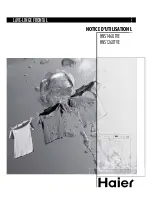
20
Figure 11
Figure 12
Figure 13
Care and Maintenance
A regular inspection and maintenance of your machine will help to pre-
vent faults. This saves time and prevents future problems.
Overall condition of the machine
Never use a steam cleaner to clean your dishwasher. The manufacturer
is not liable for any resulting damage.
Regularly wipe the front of the appliance with a damp cloth - water and
a small amount of liquid soap is adequate. Do not use sponges as they
could scratch the surfaces.
Stainless steel appliances: To prevent corrosion, do not use sponges.
Clean the outer edges of the inside door panel regularly to remove
debris that may collect from normal loading. If spots begin to appear on
the stainless steel, make sure the rinse agent is full and functioning
properly.
WARNING
Use caution when removing parts for cleaning as some debris may be sharp.
Filters
The filter system consists of a coarse filter, a
flat fine filter and a micro filter. The filters
keep large foreign objects in the rinsing water
away from the pump. Foreign objects may
occasionally block the filters.
Check the filters for residue by:
• Unscrew the filter cylinder as illustrated in
Figs. 11-12
and take out the filter system.
• Remove any residue and clean filters under
running water.
• Reinstall filter system in reverse sequence
and ensure that the arrow marks are facing
each other after locking it into place.
Spray Arms
Check spray arms for grease and limescale deposits.
If you find such deposits:
• Fill detergent dispenser with detergent and
start the appliance without utensils in the
cycle with the highest rinsing temperature
(see wash cycle information table).
• Clean the appliance with detergents/ appli-
ance cleaners which are particularly suit-
able for use with dishwashers.
• Unscrew the spray arms and inspect as
shown in
Figure 13
.
















































